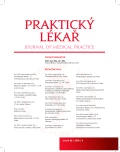Imaging methods in pregnancy – indications and contraindications and use of contrast media
Authors:
T. Rohan 1,2; M. Poláčková 1
Authors‘ workplace:
Klinika radiologie a nukleární medicíny
Fakultní nemocnice Brno
Přednosta: prof. MUDr. Vlastimil Válek, CSc., MBA, EBIR
1; Lékařská fakulta, Masarykova univerzita, Brno
2
Published in:
Prakt. Lék. 2018; 98(4): 166-169
Category:
Of different specialties
Overview
With the increasing possibilities and availability of imaging methods, we focused on a minority group of patients – pregnant women. In the article we offer a brief overview of the imaging modalities that can or cannot be used and under what conditions. Information was drawn from current Czech and foreign literature dealing with this issue. When investigating pregnant patients, the guideline applies – first of all, using imaging methods without radiation. Under certain circumstances, imaging methods using ionizing radiation must be used. In these cases, we only select those examinations that are strictly necessary to diagnose the pathological condition and we follow the ALARA (as low as reasonably achievable) principles.
Keywords:
pregnancy – imaging methods – ionizing radiation
Sources
1. Committee on obstetric practice. Committee Opinion No. 723: Guidelines for diagnostic imaging during pregnancy and lactation. Obstet Gynecol 2017; 130: e210–e216.
2. Wagner LK, Lester RG, Saldana LR. Exposure of the pregnant patient to diagnostic radiations: a guide to medical management. Madison, Wis: Medical Physics Publishing 1997.
3. Chen MM, Coakley FV, Kaimal A, et al. Guidelines for computed tomography and magnetic resonance imaging use during pregnancy and lactation. Obstet Gynecol 2008; 112 : 333–340.
4. Leyendecker JR, Gorengaut V, Brown JJ. MR imaging of maternal diseases of the abdomen and pelvis during pregnancy and the immediate postpartum period. Radiographics 2004; 24 : 1301–1316.
5. Ray JG, Vermeulen MJ, Bharatha A, et al. Association between MRI exposure during pregnancy and fetal and childhood outcomes. JAMA 2016; 316(9): 952–961.
6. Ministerstvo zdravotnictví ČR. Národní radiologické standardy – skiagrafie, obecná část. Věstník MZ č. 10/2016 [online]. Dostupné z: http://www.mzcr.cz/Legislativa/dokumenty/skiagrafie-obecna-cast_13221_3050_11.html [cit. 2018-04-01].
7. Ministerstvo zdravotnictví ČR. Národní radiologické standardy – výpočetní tomografie. Věstník MZ č. 2/2016 [online]. Dostupné z: https://www.mzcr.cz/dokumenty/vypocetni-tomografie_11424_3050_3.html [cit. 2018-04-01].
8. Ministerstvo zdravotnictví ČR. Národní radiologické standardy – intervenční radiologie. Věstník MZ č. 10/2016 [online]. Dostupné z: https://www.mzcr.cz/dokumenty/radiodiagnostika-intervencni-radiologie_8779_3050_3.html [cit. 2018-04-01].
9. Mechl M, Žižka J, Tintěra J, a kol. Kontraindikace a rizika vyšetření pomocí magnetické rezonance. Ces Radiol 2010; 64(1): 69–75.
10. Tremblay E, Thérasse E, Thomassin-Naggara I, Trop I. Quality Initiatives: Guidelines for Use of Medical Imaging during Pregnancy and Lactation. RadioGraphics 2012; 32(3): 897–911.
11. Bracco Imaging. Sonovue – souhrn údajů o přípravku [online]. Dostupné z: http://imaging.bracco.com/sites/braccoimaging.com/files/technica_sheet_pdf/cz-cs-2017-09-01-spc-sonovue.pdf [cit. 2018-04-01].
12. European Society of Urogenital Radiology. ESUR guidelines on contrast media: 8.1. [online]. Dostupné z: http://www.esur.org/guidelines/ [cit. 2018-04-01].
13. American College of Radiology. Administration of contrast media to pregnant or potentially pregnant patients [online]. Dostupné z: http://radpacs.weber.edu/images/mri/Campus/RADT 204623/Additional Articles/Contrast Pregnant.pdf [cit. 2018-04-01].
14. SÚKL. Iomeron 400 – souhrn údajů o přípravku [online]. Dostupné z: http://www.sukl.cz/download/spc/SPC19657.pdf [cit. 2018-04-01].
15. SÚKL. Ultravist 370 – souhrn údajů o přípravku [online]. Dostupné z: http://www.sukl.cz/modules/medication/detail.php?code=0224713&tab=texts [cit. 2018-04-01].
16. Webb JA, Thomsen HS, Morcos SK; Members of Contrast Media Safety Committee of European Society of Urogenital Radiology (ESUR). The use of iodinated and gadolinium contrast media during pregnancy and lactation. Eur Radiol 2005; 15(6): 1234–1240.
17. Mühler MR, Clément O, Salomon LJ, et al. Maternofetal pharmacokinetics of a gadolinium chelate contrast agent in mice. Radiology 2011; 258(2): 455–460.
18. Wieseler KM, Bhargava P, Kanal KM, et al. Imaging in pregnant patients: examination appropriateness. RadioGraphics 2010; 30(5): 1215–1229.
19. Patel SJ, Reede DL, Katz DS, et al. Imaging the pregnant patient for nonobstetric conditions: algorithms and radiation dose considerations. RadioGraphics 2007; 27(6): 1705–1722.
20. Simcox LE, Ormesher L, Tower C, Greer IA. Pulmonary thrombo-embolism in pregnancy: diagnosis and management. Breathe 2015; 11(4): 282–289.
21. Masselli G, Derchi L, McHugo J, et al. Acute abdominal and pelvic pain in pregnancy: ESUR recommendations. Eur Radiol 2013; 23(12): 3485–3500.
22. Woodring JH, Heiser MJ. Detection of pneumoperitoneum on chest radiographs: comparison of upright lateral and posteroanterior projections. Am J Roentgenol 1995; 165(1): 45–47.
23. Türk C, Petřík A, Sarica K, et al. EAU Guidelines on interventional treatment for urolithiasis. Eur Urol 2016; 69(3): 475–482.
Labels
General practitioner for children and adolescents General practitioner for adultsArticle was published in
General Practitioner

2018 Issue 4
Most read in this issue
- Endometriosis and its effect on fertility and quality of life – literature review
- Imaging methods in pregnancy – indications and contraindications and use of contrast media
- Disability pension against social stress?
- The importance of gait as the most natural physical activity in the human life style
